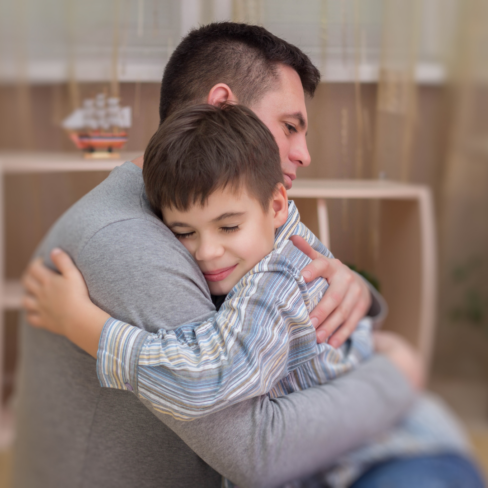

Therapist Corner: Understanding Grief in Divorce
Hello everyone, my name is Colin Sandgren, and I am one of the therapists here at Kids in the Middle. In this brief article, I want to highlight something that I often cover with children, adults, co-parents, and families that come into Kids in the Middle for support, which is the grieving process. So, let’s start here; how do we define grief? Well, there are many ways to describe grief, but the way it is often described is the process in which we work through a significant loss in our lives. This loss is often framed in the wake of death, but loss extends beyond death and can be viewed as any significant change in a person’s life (e.g., the loss of a job, divorce, a friend moving away, changing schools, etc.). Thus, loss has a much broader scope as it pertains to the grieving process. As many of you reading this article likely already know, divorce or separation is certainly a significant loss for parents and children alike to adapt and adjust to. Since the grieving process is such an integral part of divorce and separation, I wanted to briefly review the five main aspects of the grief model developed by Elisabeth Kübler-Ross. The five “stages” will help us to grasp the concept of understanding grief in divorce.
- Denial – Denial can be defined as a rejection of the new reality brought upon by the significant loss, meaning an individual may, for a period of time, refuse to believe or accept the loss that has taken place in their life. Often in divorce, both parents and children demonstrate a period where they continue their life as if it has not significantly changed in light of the divorce or separation. Children, specifically, may think to themselves, or even express to those around them, that the divorce or separation is not permanent and that their parents will be getting back together. In other cases, children will outright refuse to admit that anything is wrong or anything major has changed. Denial is a normal part of the grief process and typically will not last.
- Anger – Anger is another common part of the grieving process, and it certainly manifests during divorce and separation. Children and parents will both likely experience anger related to the divorce or separation, although it might look different. Children may act out at school, with their friends, or towards one or both parents. In addition to this, children may be observed to become disproportionately aggravated or irritated by events that do not usually elicit such a strong response. Although anger can be frustrating to deal with as a parent, it is vital to remember that your child’s anger often covers up deeper, more complex emotions, such as confusion, hurt, and feeling overwhelmed. It is also normal to be angry about a loss or a change. And just as denial, this eventually subsides.
- Bargaining – Bargaining is a part of the grieving process that sees those grieving “bargain or barter” to bring back what has been lost. In a divorce or separation situation, a child might write letters to their parents saying that the other parent is sorry for everything and wants to get back together. Another example is that a child may try to be the “best” child they can be, hoping that their good behavior will bring their parents closer together. Although it might feel like bargaining is a step back in a child’s overall adjustment to separation or divorce, it can actually be a sign of progress. In fact, it is a step above denial, as the child is no longer “avoiding their reality” but attempting to alter it. Bargaining can be hard to observe, but this is a typical and normal process for many grieving children of separation or divorce.
- Depression – Depression is the part of the grieving process where feelings of extreme sadness, hopelessness, and defeat are most prevalent within an individual. Within children of separation or divorce, a child may become unusually tearful, show signs of increased or decreased attachment toward one or both parents, or engage in isolating behaviors (e.g., spending more time alone in their room, spending less time with their friends, etc.). Again, this part of grief can be concerning, but it is normal and shows further signs of progress toward acceptance.
- Acceptance – Acceptance is thought to be the “end” (if there is such a thing) of the grieving process. Acceptance does not mean that an individual loves or embraces the loss or change they have experienced, but more so that they are willing and ready to begin to move forward within a world that looks different than it once did. This means that although a child may not love or embrace the idea of divorce or separation, they will adjust and adapt in a generally positive manner.
Above was a simple, succinct, and extremely abbreviated description of the main stages of the Kübler-Ross model of grief (if you are interested in learning more about these stages and the research behind them, I encourage you to explore Kübler-Ross’s work). As I mentioned earlier in this article, grief is an integral part of the separation process for families. I have highlighted the model above to encourage parents to share the grief process with their children as they grapple with the difficult and tasking feelings that divorce and separation evoke within them. As adults, I think most of us have a general understanding of what grief is and have likely experienced various moments of grief throughout our lives. Children, however, do not have the same experience with grief that adults tend to have, making them more vulnerable to the cruelty that grief can cause. With this in mind, providing them with a model or process can be extremely helpful for them, as it can normalize their complicated and complex feelings. Also, discussing this grief process with your children can open the door for future positive conversations about grief, separation, complex feelings, and so forth. It is important to note that although this grief model is a powerful tool, every individual and every child handles loss differently.
Furthermore, this model is described in a linear fashion, meaning that each stage is progressive of the last. However, real-life grief is more complicated, and it is better to think of each stage as existing in a sort of cycle, where individuals alternate in and out of varying stages. Grief is a life-long process, and certain times and events will elicit strong grief-related feelings. Nonetheless, individuals (including children) spend more time experiencing feelings of acceptance and less time grappling with feelings of denial, bargaining, anger, and sadness over time. Finally, it is not uncommon for individuals, especially children, to become “stuck” in a certain stage of grief. If this happens, remember to respond with patience and understanding and seek professional help when needed.

Colin Sandgren, MS
